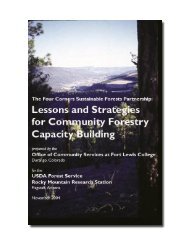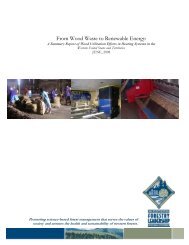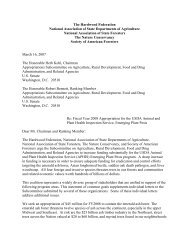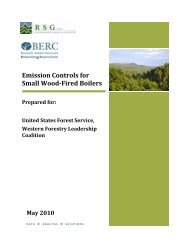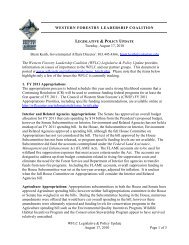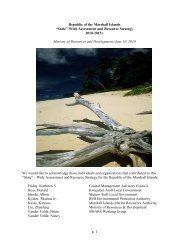Marketing and Communications: Tools for Repositioning Urban and ...
Marketing and Communications: Tools for Repositioning Urban and ...
Marketing and Communications: Tools for Repositioning Urban and ...
You also want an ePaper? Increase the reach of your titles
YUMPU automatically turns print PDFs into web optimized ePapers that Google loves.
<strong>Marketing</strong> <strong>and</strong> <strong>Communications</strong>:<br />
<strong>Tools</strong> <strong>for</strong> <strong>Repositioning</strong><br />
<strong>Urban</strong> <strong>and</strong> Community Forestry<br />
Paul D. Ries<br />
Oregon Department of Forestry
What Do People Think About <strong>Urban</strong> Forestry?<br />
Where we are<br />
• Trees are a<br />
discretionary<br />
budget item<br />
that is nice<br />
to have<br />
• Trees make<br />
our city<br />
pretty<br />
Where we need to be<br />
• Trees make a central<br />
contribution to what<br />
makes our city<br />
livable - a necessity<br />
• Trees help solve<br />
community problems<br />
<strong>and</strong> are a vehicle to<br />
address community<br />
goals
Positions of Existing City Services<br />
• Police/Public Safety<br />
•Fire Protection<br />
• Water/Sewer<br />
• Economic Development<br />
• Transportation/Traffic Safety<br />
• Planning/Growth Management<br />
• Education/Youth<br />
• Public Health<br />
• Parks/Trees<br />
• Libraries<br />
•Arts
Can We Reposition <strong>Urban</strong> Forestry?<br />
(adapted from Dr. John Crompton - Texas A&M)<br />
• Positioning, in an urban <strong>for</strong>estry context,<br />
refers to the place your program occupies<br />
in the minds of decision-makers <strong>and</strong> the<br />
public<br />
• <strong>Repositioning</strong> means linking what you’ve<br />
got to what community problems you can<br />
solve or community issues you can<br />
address
In Order To Reposition,<br />
You Must Be Willing To:<br />
• Critically assess where you are<br />
• Measure your past success<br />
• Plan strategically <strong>for</strong> the future position<br />
you’d like to hold<br />
• Communicate your successes in terms<br />
that match where you’d like to be
Aligning With Community Issues <strong>and</strong><br />
Problems You Can Help Solve<br />
• Resonate with the<br />
political issues <strong>and</strong><br />
priorities<br />
• Be allied with other<br />
community benefits<br />
• Think outside the bark
The <strong>Repositioning</strong> Planning Process<br />
#4<br />
How do we get<br />
what we want?<br />
#1<br />
Where do<br />
we want<br />
to be?<br />
#3<br />
What<br />
problems<br />
can we<br />
solve?<br />
#2<br />
What do we<br />
have to<br />
contribute?
The <strong>Repositioning</strong> Planning Process<br />
• Where do we want to be?<br />
– An essential city service<br />
– A necessity, not a nicety<br />
– A solution to community problems<br />
– A key to what makes our city livable
The <strong>Repositioning</strong> Planning Process<br />
• What do we have to contribute?<br />
–A clean air factory<br />
– A stormwater control mechanism<br />
– An economic engine
The <strong>Repositioning</strong> Planning Process<br />
• What problems can we solve?<br />
–Crime<br />
– Economic decline<br />
– Environmental degradation
The <strong>Repositioning</strong> Planning Process<br />
• How do we get what we want?<br />
– Realign our planning components<br />
– Make connections to issues <strong>and</strong> people<br />
– Think strategically<br />
– Communicate effectively
Communicating The Need For Trees<br />
• Most people take trees<br />
<strong>for</strong> granted, or don’t<br />
know much about urban<br />
<strong>for</strong>estry<br />
• The trees in our cities<br />
are important, <strong>and</strong> they<br />
must be cared<br />
<strong>for</strong>…communications<br />
<strong>and</strong> public relations are<br />
how we get that<br />
message across
Communicating the Need For Trees<br />
• People today want proof<br />
– we need to provide<br />
factual evidence of the<br />
benefits <strong>and</strong> costs<br />
• Demonstrate financial as<br />
well as quality of life<br />
consequences<br />
• We need to connect with<br />
them if we’re going to<br />
communicate with them<br />
For every dollar<br />
invested in<br />
urban<br />
<strong>for</strong>estry,<br />
$2.70 is<br />
returned
Why We Communicate:<br />
• To transfer in<strong>for</strong>mation<br />
• To transfer knowledge<br />
• To convince the listener<br />
• To educate the listener<br />
• To gain acceptance<br />
• To gain support<br />
•To change minds<br />
•To make decisions<br />
• To create, maintain, <strong>and</strong><br />
trans<strong>for</strong>m relationships
Strategic <strong>Communications</strong><br />
• We can learn from the art<br />
of communication to<br />
advance urban <strong>for</strong>estry<br />
• If we are going to<br />
communicate to change<br />
minds, to convince the<br />
listener, or to gain<br />
support, then that<br />
communication must be<br />
STRATEGIC
A <strong>Marketing</strong> Strategy <strong>for</strong><br />
<strong>Urban</strong> & Community Forestry in the West<br />
Developed by:<br />
The Western<br />
Forestry Leadership<br />
Coalition’s<br />
Western <strong>Urban</strong> <strong>and</strong><br />
Community Forestry<br />
Committee
Western Forestry<br />
Leadership Coalition<br />
23 Western State & Pacific Isl<strong>and</strong> Foresters (Council<br />
of Western State Foresters - 1967)<br />
+ 7 USDA-FS western Regional Foresters<br />
+ 3 USDA-FS western Research Station Directors<br />
+ 1 Forest Products Lab Director =<br />
------------------------------------------------------------<br />
34 WFLC Members
We needed One<br />
Western Voice to be Heard<br />
We wanted to:<br />
Launch western initiatives<br />
Communicate the unique western challenges<br />
<strong>and</strong> issues<br />
Maximize western federal <strong>and</strong> state financial<br />
investments<br />
Tackle emerging western issues by providing<br />
research, recommending policies, <strong>and</strong><br />
coordinating ef<strong>for</strong>ts across l<strong>and</strong> ownerships
Big Issues in the West<br />
•Endangered Species<br />
• <strong>Urban</strong>/Wild<strong>and</strong> Interface<br />
•Population growth<br />
•Development<br />
• Invasive Species
Western <strong>Urban</strong> <strong>and</strong> Community<br />
Forestry Committee<br />
• The mission of the WUCFC is to promote healthy<br />
<strong>and</strong> sustainable urban <strong>and</strong> community <strong>for</strong>est<br />
ecosystems in the west.<br />
• We provide advice <strong>and</strong> recommendations,<br />
thereby helping to focus a western approach <strong>and</strong><br />
a unified voice to urban <strong>and</strong> community <strong>for</strong>estry.<br />
• We serve the Council of Western State Foresters<br />
as a component of the Western Forestry<br />
Leadership Coalition (WFLC). As such, the WUCFC<br />
works collaboratively as a state-federal<br />
partnership to promote the mission of the WFLC.
A <strong>Marketing</strong> Strategy <strong>for</strong><br />
<strong>Urban</strong> & Community Forestry in the West<br />
• Developed to communicate <strong>and</strong> promote the<br />
benefits of <strong>Urban</strong> <strong>and</strong> Community Forestry in the<br />
17 western states <strong>and</strong> Pacific Isl<strong>and</strong>s.<br />
• Desire to position <strong>Urban</strong> <strong>and</strong> Community Forestry<br />
in the West so that it more clearly resonates with<br />
federal, state, <strong>and</strong> local decision makers who<br />
control resources <strong>and</strong> can influence support <strong>for</strong><br />
U&CF ef<strong>for</strong>ts.
Goals of the Strategy<br />
1. Increase the awareness of <strong>and</strong> support <strong>for</strong><br />
urban <strong>for</strong>estry among policy-makers in the<br />
West<br />
2. Foster a greater underst<strong>and</strong>ing of the<br />
importance of urban <strong>for</strong>ests in meeting the<br />
economic, environmental, <strong>and</strong> social needs of<br />
communities<br />
3. Engage a diverse set of partners <strong>and</strong> motivate<br />
them to support sustainable urban <strong>for</strong>estry<br />
programs
Key Messages of the Strategy<br />
1. <strong>Urban</strong> <strong>for</strong>ests provide essential benefits we<br />
cannot live without (benefits)<br />
2. A healthy urban <strong>for</strong>est doesn’t happen by<br />
chance - it is the result of proper planning,<br />
management, <strong>and</strong> community investment<br />
(investments)<br />
3. Healthy urban <strong>for</strong>ests can help solve many<br />
community problems (solutions)<br />
4. <strong>Urban</strong> <strong>for</strong>est <strong>and</strong> rural <strong>for</strong>ests are connected;<br />
good management of one helps the other<br />
(connections)
How the Strategy Will Be Used<br />
• Align state <strong>and</strong> west-wide ef<strong>for</strong>ts to<br />
provide <strong>for</strong> common messages <strong>and</strong><br />
themes within state priorities<br />
• Guide the Committee’s work <strong>for</strong> the<br />
next 5 years<br />
• Help states initiate or improve their<br />
won communication <strong>and</strong> marketing<br />
ef<strong>for</strong>ts
Bringing it to a Local Level<br />
• Synergize ef<strong>for</strong>ts<br />
• Provide framework <strong>for</strong> creating changes<br />
• Help local programs build sustainability<br />
• Help local programs communicate the<br />
case <strong>for</strong> trees
Strategies For Communicating Trees<br />
1. Define your desired outcome<br />
2. Identify your target audience<br />
3. Select/Refine your key message<br />
4. Select your tools <strong>and</strong> methods<br />
5. Recruit collaborators
Strategy 1: Define The Desired<br />
Outcome Of Your Communication<br />
• Start with the end in<br />
mind<br />
• Scenarios <strong>and</strong> futures<br />
• Identify the<br />
limitations or<br />
problems in advance<br />
• Anticipate the<br />
unexpected
Strategy 2:<br />
Identify Your Target Audience<br />
• Whose problem can you solve through<br />
trees?<br />
• What individuals or groups can be<br />
influenced <strong>for</strong> your cause?<br />
• Which of these individuals or groups will<br />
give you the greatest return on your<br />
investment of time?
Strategy 3:<br />
Select/Refine Your Key Message<br />
• What main point are you<br />
trying to get across?<br />
• How much detail is needed?<br />
• Four aspects of a Key Message<br />
–Who says it<br />
– What they say<br />
– How they say it<br />
– What image it conveys
Strategy 4: Select The Right <strong>Tools</strong> & Methods<br />
• Know what you are trying<br />
to achieve via media or<br />
public outreach<br />
• Target the communication<br />
in the proper <strong>for</strong>mat<br />
• Ask what the recipient<br />
needs <strong>and</strong> provide details
Strategy 5: Recruit Collaborators<br />
• Not much gets done in urban <strong>for</strong>estry<br />
without partners<br />
• Who are your partners?<br />
• What can they do <strong>for</strong> you?<br />
• What can you do <strong>for</strong> them?
Communicating Trees<br />
• <strong>Urban</strong> <strong>for</strong>estry involves<br />
people - we must<br />
communicate, not to<br />
them, but with them<br />
• Think of urban <strong>for</strong>estry as<br />
the process of managing<br />
the relationship between<br />
people <strong>and</strong> trees
What Results From A Failure To<br />
Communicate…<br />
Don’t let this be you…or your urban <strong>for</strong>estry program…



